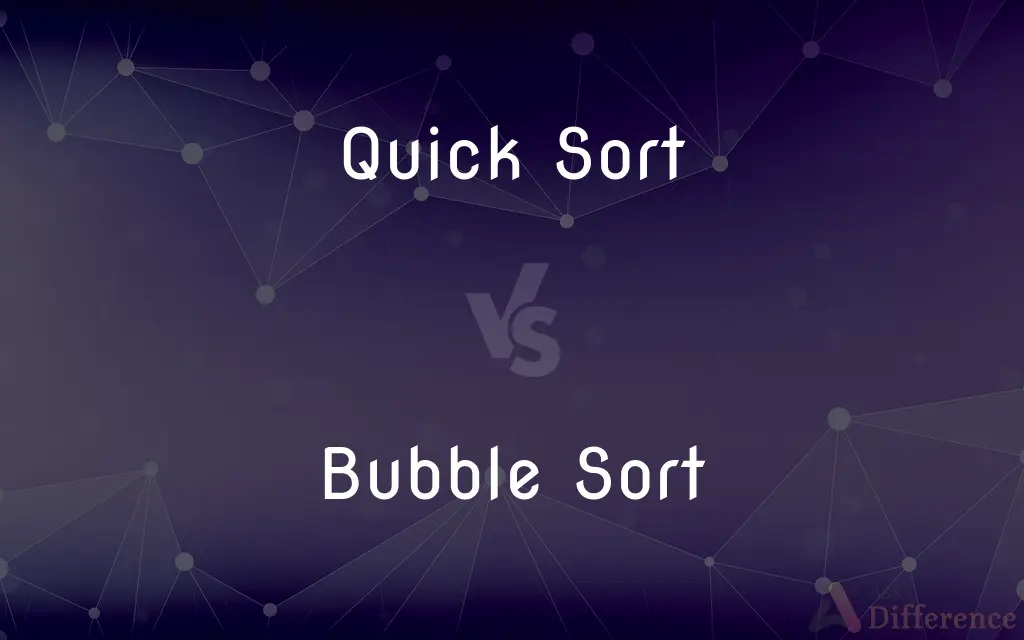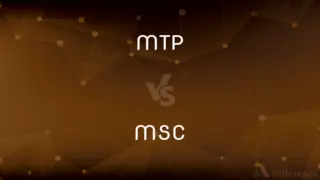Quick Sort vs. Bubble Sort — What's the Difference?
Edited by Tayyaba Rehman — By Fiza Rafique — Published on December 22, 2023
Quick Sort is a divide-and-conquer sorting algorithm that partitions data and sorts recursively, while Bubble Sort repeatedly steps through the list, comparing and swapping adjacent items if necessary.

Difference Between Quick Sort and Bubble Sort
Table of Contents
ADVERTISEMENT
Key Differences
Quick Sort is a widely used sorting algorithm that employs the divide-and-conquer approach. By selecting a "pivot" and partitioning other elements into sub-arrays based on this pivot, Quick Sort can efficiently sort data. On the other hand, Bubble Sort operates by repeatedly going through the list and comparing adjacent elements, swapping them if they're in the wrong order. The process ensures that after each pass-through, the largest element bubbles up to its correct position.
The efficiency of Quick Sort often surpasses that of Bubble Sort, especially for larger datasets. This is because Quick Sort can achieve an average time complexity of O(n log n), making it faster in general scenarios. Bubble Sort, however, has a worst-case and average time complexity of O(n^2), which can make it much slower when dealing with large lists.
While Quick Sort's performance is typically superior, there are cases where Bubble Sort might be preferred. For small datasets, the simplicity of Bubble Sort can sometimes lead to faster real-world performance due to fewer overheads. Moreover, Bubble Sort is a stable sort, meaning that the relative order of equal sort items remains unchanged, whereas Quick Sort doesn't guarantee this.
Both Quick Sort and Bubble Sort have their places in computer science and programming. Quick Sort is preferred when efficiency is paramount and the data set is large. Bubble Sort, with its straightforward implementation, may be chosen for educational purposes, smaller datasets, or when stability is a concern.
Comparison Chart
Method
Divide-and-conquer
Repeatedly stepping through the list
ADVERTISEMENT
Average Complexity
O(n log n)
O(n^2)
Worst-case Complexity
O(n^2), though rare with good pivots
O(n^2)
Stability
Not stable by default
Stable
Common Use Case
Large datasets
Small datasets or educational purposes
Compare with Definitions
Quick Sort
Quick Sort is a divide-and-conquer sorting algorithm.
For large datasets, many developers prefer using Quick Sort due to its efficiency.
Bubble Sort
Bubble Sort is a stable sorting algorithm.
In situations where the relative order of equal elements must be preserved, Bubble Sort can be a good choice.
Quick Sort
Quick Sort operates recursively to sort elements.
The recursive nature of Quick Sort helps in breaking the problem down into manageable chunks.
Bubble Sort
Bubble Sort has an average and worst-case time complexity of O(n^2).
Due to its time complexity, Bubble Sort might not be ideal for very large lists.
Quick Sort
Quick Sort does not guarantee stability in sorting.
When the order of equal elements matters, Quick Sort might not be the best choice.
Bubble Sort
Bubble Sort ensures that after each iteration, the next largest element moves to its right place.
Like bubbles rising in water, Bubble Sort pushes the largest numbers to the end of the list.
Quick Sort
Quick Sort partitions data based on a selected pivot.
By choosing an optimal pivot, the Quick Sort algorithm can achieve better performance.
Bubble Sort
Bubble Sort operates by repeatedly comparing and swapping adjacent elements.
After every pass in Bubble Sort, the largest element finds its correct position.
Quick Sort
Quick Sort often has an average time complexity of O(n log n).
Given its time complexity, Quick Sort is suitable for sorting extensive lists.
Bubble Sort
Bubble Sort is a comparison-based sorting algorithm.
For educational purposes, Bubble Sort is often introduced to beginners.
Common Curiosities
How does Quick Sort handle the partitioning of data?
Using a pivot, it divides data into sub-arrays, sorting them recursively.
What principle does Quick Sort operate on?
It operates on the divide-and-conquer principle.
How does Bubble Sort get its name?
Because larger elements "bubble" to the end of the list with each pass.
Is Bubble Sort suitable for large datasets?
Typically no, due to its O(n^2) average time complexity.
Can Bubble Sort be optimized for slightly better performance?
Yes, by checking if no swaps occurred in a pass, indicating the list is already sorted.
How does the performance of Quick Sort compare to Merge Sort?
Both have an average time complexity of O(n log n), but the constant factors and real-world performance might differ based on the dataset and implementation.
In what scenario might Quick Sort have a performance similar to Bubble Sort?
In its worst-case scenario, with a consistently bad choice of pivots.
What happens in Quick Sort if a bad pivot is consistently chosen?
The algorithm's performance degrades to O(n^2), similar to Bubble Sort's average performance.
Is Quick Sort always faster than Bubble Sort?
Generally yes for large datasets, but not necessarily for very small ones.
Why might one choose Bubble Sort over more efficient algorithms?
Its simplicity, stability, or for educational purposes.
How does the stability of Bubble Sort compare to Quick Sort?
Bubble Sort is stable, whereas Quick Sort is not inherently stable.
Can Quick Sort be made stable?
Yes, with modifications to its standard implementation.
Why is Bubble Sort considered a stable sort?
Because the relative order of equal elements remains unchanged.
How many passes does Bubble Sort typically make for a list of n elements?
In the worst case, it can make n-1 passes.
Which sorting algorithm, Quick Sort or Bubble Sort, requires more memory overhead?
Quick Sort, especially in its recursive implementation, can require more memory overhead due to the call stack.
Share Your Discovery

Previous Comparison
MTP vs. MSC
Next Comparison
Manchu Facial Features vs. Han Facial FeaturesAuthor Spotlight
Written by
Fiza RafiqueFiza Rafique is a skilled content writer at AskDifference.com, where she meticulously refines and enhances written pieces. Drawing from her vast editorial expertise, Fiza ensures clarity, accuracy, and precision in every article. Passionate about language, she continually seeks to elevate the quality of content for readers worldwide.
Edited by
Tayyaba RehmanTayyaba Rehman is a distinguished writer, currently serving as a primary contributor to askdifference.com. As a researcher in semantics and etymology, Tayyaba's passion for the complexity of languages and their distinctions has found a perfect home on the platform. Tayyaba delves into the intricacies of language, distinguishing between commonly confused words and phrases, thereby providing clarity for readers worldwide.














































